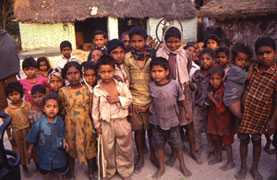Pertussis in Other Countries
Español: Tosferina en otros países

In 2015, the World Health Organization reported 142,512 pertussis cases globally, and estimated that there were 89,000 deaths. However, a recent publication modeling pertussis cases and deaths estimates that there were 24.1 million pertussis cases and 160,700 deaths in children younger than 5 years in 2014 worldwide.
While Bordetella pertussis circulates worldwide, disease rates are highest among young children in countries where vaccination coverage is low, primarily in the developing world. In developed countries, the incidence of pertussis is highest among unvaccinated babies and increases again among teens.
Pertussis remains one of the leading causes of vaccine-preventable deaths worldwide, despite overall high vaccination coverage. Most pertussis deaths occur in young babies who are either unvaccinated or incompletely vaccinated.
If traveling internationally, read the Travelers’ Health Yellow Book chapter on pertussis.

The Latin American Pertussis Project (LAPP) is a collaboration between the Meningitis and Vaccine Preventable Diseases Branch within CDC’s Division of Bacterial Diseases, the Sabin Vaccine Institute, the Pan American Health Organization, and the Ministries of Health in select Latin American countries. The goal of LAPP is to expand the understanding of current pertussis epidemiology in Latin America in order to guide national and regional pertussis prevention and control strategies.
The following web pages provide information about LAPP partners, as well as resources on pertussis surveillance, laboratory diagnostics, and vaccines.
References
- Yeung KHT, Duclos P, Anthony E, et al. An update of the global burden of pertussis in children younger than 5 years: A modelling study. Lancet. Epub ahead of print. 2017.
- WHO Immunization Coverage Factsheet.
- Liu L, Oza S, Hogan D, et al. Global, regional, and national causes of child mortality in 2000-13, with projections to inform post-2015 priorities: An updated systematic analysis. Lancet. 2015;385:430–40.
- Black RE et al, for the Child Health Epidemiology Reference Group of WHO and UNICEF. Global, regional, and national causes of child mortality in 2008: a systematic analysis. Lancet. 2010; 375:1969–87.
- Crowcroft NS, Stein C, Duclos P, et al. How best to estimate the global burden of pertussis. Lancet Infect Dis. 2003;3:413–8.
Related Pages
- Page last reviewed: August 7, 2017
- Page last updated: August 7, 2017
- Content source:


 ShareCompartir
ShareCompartir